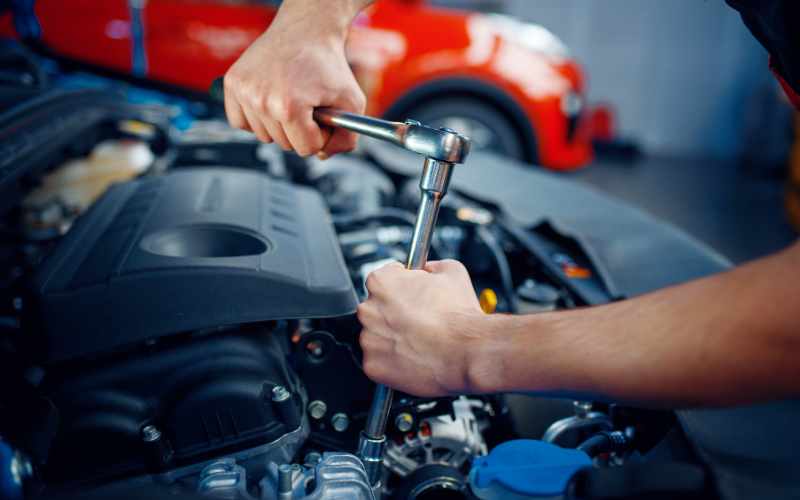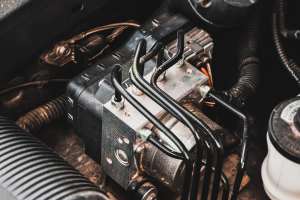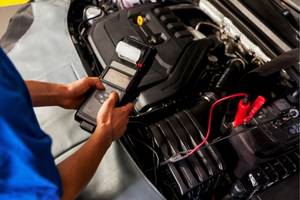Introduction
Car problems — they're a real pain, aren't they? But what if I told you that understanding the core of your car's electronic system, the Powertrain Control Module (PCM), can save you a lot of mechanic trips? And better yet, that you can learn some of the best practices for automotive PCM repair yourself. In this guide, we'll explore common PCM problems, the efficient use of diagnostic tools, successful repair techniques, and tips for maintaining PCM longlife. By the end, you'll be provided with the knowledge to keep your vehicle running smoothly.
1. Identify Common PCM Problems
The first step in your PCM repair journey is to know the enemy. What types of issues usually plague this tiny car brain? Here's a handy list to guide you:
Engine Misfires: If your vehicle's engine is misfiring, the PCM might be the culprit. Remember, the PCM controls your engine's ignition system, so any glitches here could lead to a misfire.
Poor Fuel Economy: Noticed you're refueling more often than usual? This could be the result of a faulty PCM messing with your fuel injection system.
Transmission Problems: If changing gears feels like riding a mechanical bull, that's a clear sign of PCM troubles.
Random Check Engine Light: We all hate that pesky light — especially when it seems to have a mind of its own. But guess what? It could be an indication of PCM issues.
Unpredictable Vehicle Behaviour: Lastly, if your vehicle has temper tantrums — stalling, not starting, or shutting off randomly — it's likely the PCM is having a bad day.
Now you can see why knowing the best practices for automotive PCM repair is so important. These problems are not only inconvenient but can lead to more serious issues if not addressed. So, how about we move to the part you're waiting for: using diagnostic tools effectively? That's coming up in the next section, so stay tuned!
So, you're familiar with the common PCM problems. But how do you figure out if your car's PCM is indeed the one throwing a wrench in the works? For this, my friend, you need to harness the power of diagnostic tools.
On-Board Diagnostics (OBD): This is your first line of defense. An OBD scanner can provide you with error codes that point towards potential PCM problems. Just plug it into the OBD port, usually located under the dashboard, and let it do its magic. But remember, interpreting the codes correctly is just as important as obtaining them.
Multimeter: This handy device can help you check the PCM's power and ground circuits. If you spot any irregularities in voltage or resistance — bingo, you've found your culprit.
Oscilloscope: For the more advanced users, an oscilloscope can be a great tool to visualize the electrical signals. It's particularly useful in detecting issues with the PCM's input and output signals.
Manufacturer's Diagnostic Software: Many car manufacturers offer proprietary diagnostic software that can provide more detailed information specific to the vehicle model. It's like having a personal translator for your car's language!
Mastering these tools is a key aspect of the best practices for automotive PCM repair. And remember, practice makes perfect. So, don't be discouraged if you don't get it right away. Keep at it, and you'll become a PCM whisperer in no time. Now, let's move on to some repair techniques — and no, you won't need a hammer for this!

3. Implement Successful Repair Techniques
Congratulations! You've scaled the mountain of diagnostic tools and emerged victorious. Now, it's time to get your hands dirty with some repair work. Here's a little secret — learning to repair a PCM is less about brute force and more about finesse. Ready to dive in?
3.1 Start with a Clean Slate
Before you get started, disconnect the battery and remove the PCM from your vehicle. We're dealing with electronics here, so it's better to be safe than sorry. Plus, a clean, isolated work environment makes it easier to spot those pesky issues.
3.2 Inspect the PCM
Perform a thorough visual inspection of the PCM. Look for any obvious signs of damage like burns, corrosion, or loose connections. Sometimes, the problem is as simple as a broken wire or a corroded connector. Hey, we've all had our "is that all it was?" moments, haven't we?
3.3 Test the Components
Using your multimeter, check the resistors, capacitors, and other components on the PCM. Remember, these are the small parts that make the big picture work. If any component is faulty, it needs to be replaced.
3.4 Resolder and Replace
If you find any loose or damaged solder joints, grab your soldering iron and get to work. Similarly, if you discover any damaged components, they'll need to be replaced. Think of it as giving your PCM a bit of a facelift!
3.5 Verify and Reinstall
Once you're done with the repairs, it's time to verify your work. Use your diagnostic tools again to ensure everything's in order. If all checks out, pop the PCM back in, reconnect the battery, and take your car for a spin.
These are some of the best practices for automotive PCM repair. It's a delicate dance between diagnostics and repairs, but once you get the rhythm, you'll be twirling around the floor like a pro. Now, how about we talk about how to make sure your PCM stays in top shape post-repair? Let's keep those engines revving!
4. Maintain PCM Longevity Post-Repair
Well done on successfully navigating the repair process! But, as any seasoned mechanic will tell you, the job isn't over just yet. PCM longevity is critical in ensuring your vehicle remains in top condition for years to come. So, let's roll up our sleeves and explore some strategies to keep your PCM purring like a kitten.
4.1 Regular Check-ups
Just like us, our cars need regular check-ups too. Regular diagnostic scans can help you catch potential problems before they become real headaches. It's a simple step but one that goes a long way in maintaining the overall health of your PCM.
4.2 Keep it Clean
Dirt and grime are a PCM's worst enemies. Keep your PCM and its connectors clean to avoid corrosion and damage. A bit of preventive cleaning can save you a heap of trouble down the line.
4.3 Protect from Heat
Heat can damage the delicate components of your PCM. Try to park in the shade when possible, and consider using a windshield sun protector. A cool car is a happy car!
4.4 Regular Software Updates
Automotive manufacturers often release software updates to improve performance and fix bugs. Staying updated is one of the best practices for automotive PCM repair and longevity. It's like giving your PCM a new lease on life.
4.5 Battery Care
A faulty battery can wreak havoc on your PCM. Regularly check your battery and replace it if needed. It's a small step that can make a big difference in the life of your PCM.
Maintaining PCM longevity isn't rocket science, it's about regular care and attention. Following these best practices for automotive PCM repair can help ensure your vehicle stays on the road longer. After all, a well-maintained car is more than just a vehicle—it's a trusted companion. Now, ready to dive into some real-world success stories? Let's move on to some case studies.
5. Case Studies: Successful PCM Repair
Now, let's step into the real world. I'll share a couple of stories where the best practices for automotive PCM repair were put to test and emerged victorious. Remember, every car is unique, and so is its story. Let's get started!
5.1 The Ford Fiasco
The Ford F150, a behemoth of a vehicle, was once brought into the shop with a mysterious case of periodic stalling. After a thorough diagnosis, the culprit was found - a faulty PCM. Using the right diagnostic tools, the repair was successfully carried out, and the PCM was updated to the latest software. The truck was given a clean bill of health and hasn't missed a beat since. This goes to show how regular diagnostics and software updates can make a world of difference.
5.2 The Honda Hustle
A Honda Accord was experiencing a series of electrical misfires. Upon inspection, it was discovered that the issue lay with the PCM. As it turned out, the PCM connectors had become corroded due to lack of cleaning. Once the connectors were cleaned and the PCM was repaired, the car was back to its old self. The Honda Hustle is a classic example of the importance of cleanliness in maintaining PCM longevity.
5.3 The Nissan Narrative
A Nissan Altima was brought in with a fault code indicating a PCM problem. The battery was found to be the culprit—it was old and causing voltage fluctuations, leading to PCM malfunction. A swift battery replacement followed by a PCM repair, and the car was good as new. This case underscores the importance of battery care in successful automotive PCM repair.
These case studies bring to life the importance of the best practices for automotive PCM repair we discussed earlier. They show how regular check-ups, cleaning, heat protection, software updates, and battery care can save the day. So, what's your car's story going to be?
Conclusion
Maintaining and repairing your vehicle's PCM doesn't have to be a frightening task. With the right knowledge and tools, you can determine common problems, use diagnostic tools effectively, and implement successful repair techniques. Regular maintenance and care will make sure your PCM remains in excellent condition, saving you time and money in the long run. Take up these best practices, and you'll transform car troubles into manageable challenges, keeping your vehicle reliable and your peace of mind intact.
FAQs on
Best Practices Automotive PCM Repair: A Comprehensive Guide
-
1. What is the Powertrain Control Module (PCM)?
Ans.
The PCM is the central electronic control unit in your car that manages the engine and transmission. It makes sure ideal performance by regulating various functions such as fuel injection, ignition timing, and emissions.
-
2. What are common symptoms of a faulty PCM?
Ans.
Some common symptoms include engine misfires, poor fuel economy, transmission issues, random check engine light activations, and unpredictable vehicle behavior like stalling or not starting.
-
3. How can I diagnose PCM problems?
Ans.
Using diagnostic tools such as an On-Board Diagnostics (OBD) scanner, multimeter, oscilloscope, and manufacturer's diagnostic software can help determine PCM issues by providing error codes and visualizing electrical signals.
-
4. Can I repair a PCM myself?
Ans.
Yes, with the right tools and knowledge, you can perform basic PCM repairs. This involves inspecting for visible damage, testing components with a multimeter, resoldering joints, and replacing faulty parts. However, complicated repairs may require professional assistance.
-
5. How can I maintain my PCM to prevent future issues?
Ans.
Regular diagnostic scans, keeping the PCM clean, protecting it from heat, staying updated with software, and making sure your battery is in good condition are key practices for maintaining PCM longlife.
-
6. Are there any real-world examples of successful PCM repairs?
Ans.
Yes, case studies such as the repair of a Ford F150 with periodic stalling, a Honda Accord with electrical misfires, and a Nissan Altima with a PCM issue due to an old battery highlight the effectiveness of regular diagnostics, cleanliness, and battery care in PCM repairs.



